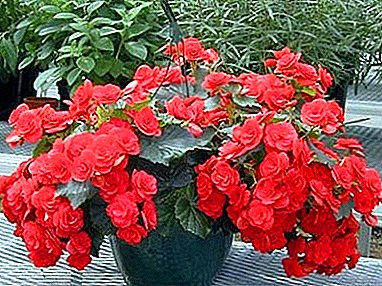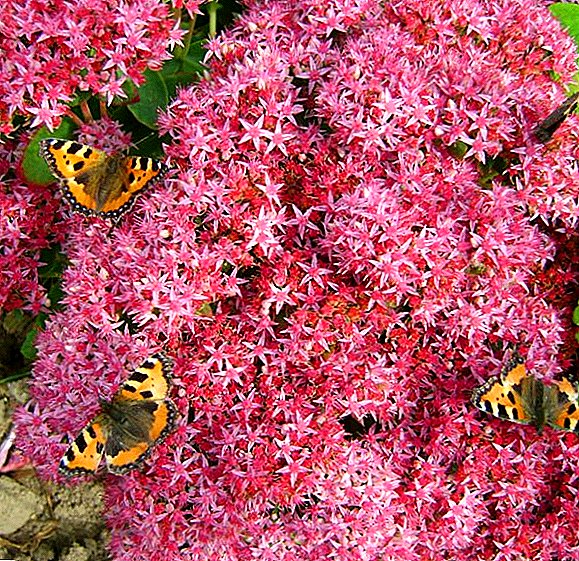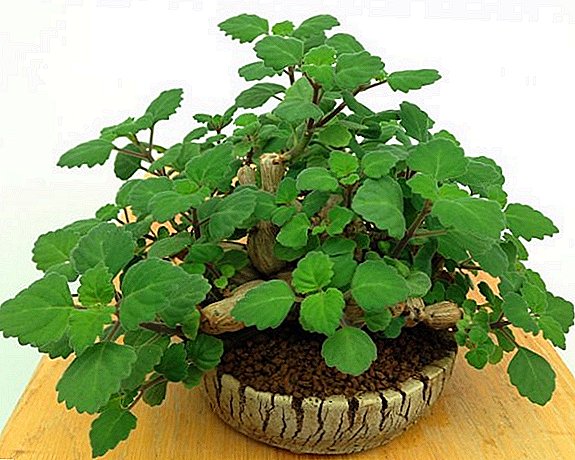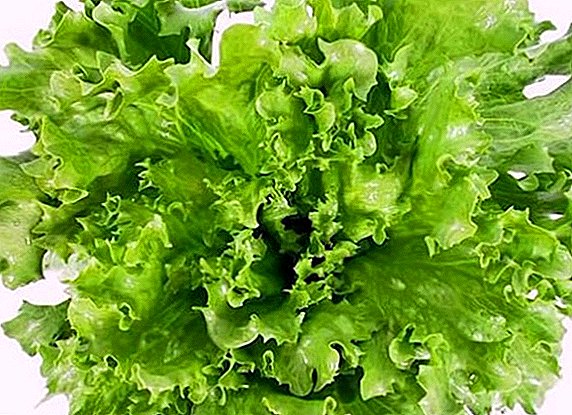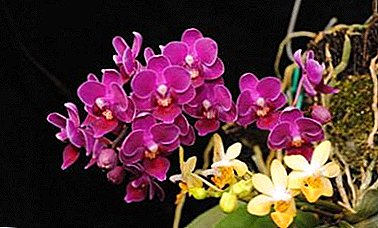
Multiflora Orchid - a flower - an aristocrat, refined and refined. Two centuries ago, orchids were available only to persons of royal nobility. The Royal Horticultural Society of London is still keeping official registration of the cultivated varieties. Today, to grow a luxurious flower is available to any grower, even at home.
What it is?
Multiflora Orchid - bred hybrid variety of the Orchid family. The flower belongs to the genus of epiphytic and lithophytic plants. Natural varieties grow in the gorges of mountains, rocky areas, can be fixed and grow even on the stumps and trunks of trees. Homeland is considered to be southeast Asia, Australia, the Philippines.
Detailed description of the plant
 Phalaenopsis Multiflora has an average height. The height of an adult flower is 45-50 cm. The leaves are fleshy, oblong, rather large, up to 35 cm in length. The color of the leaf plate is bright green. A leaf rosette can form up to 10 leaves.
Phalaenopsis Multiflora has an average height. The height of an adult flower is 45-50 cm. The leaves are fleshy, oblong, rather large, up to 35 cm in length. The color of the leaf plate is bright green. A leaf rosette can form up to 10 leaves.
The usual number of leaves - 4 - 6. The flower produces up to 5 - 6 long peduncles. Peduncles thin, fragile, slightly branched. In the year the flower produces 3 peduncle. Inflorescences combine up to 15 flowers. Adult bush can immediately give up to 40 flowers. The flowers are small, arranged oppositely, up to 4 - 5 cm in diameter. The colors are varied. There are white, pink, light purple, variegated flowers, depending on the type of clone.
History of
Orchid Multiflora - "multi", "many-flowered" - the result of the work of modern breeding. The history of natural parents is centuries old. Phalaenopsis was discovered in the 18th century by the traveler Karl Blume in the Malay Archipelago. Phalaenopsis - literally - "looks like a butterfly." The derived Multiflora variety is a classic hybrid that has passed dozens of generations of primordial varieties. This is an adapted orchid variety. The flower is well adapted to domestic conditions.
What is the difference from other species?
Orchid Multiflora differs abundant lush flowering, flowers are densely arranged.. A hybrid variety can do without rest, with proper care it blooms several times a year.
Peculiarity of leaf growth: as soon as a new leaf grows, one of the old ones fades. The growth point of the flower is absent, flowering stems grow directly from the ground. Peduncles differ branching, have many branches, on which flowers are formed.
Description of the subsorts of this species with a photo
Multiflora varietal orchid clones a lot. Consider the most popular ones, with photos and titles:
"Zebra"

The height of an adult flower is up to 35 cm. The diameter of the flowers themselves is up to 4 - 5 cm. The bloom is thick and generous. The colors of the flowers themselves are unusual - the white field of petals is striated with purple stripes.
We recommend to watch the video about the features of Zebra multiflora:
"Rembrandt"

Hybrid variety from the Netherlands. The flowers are large, up to 6 - 8 cm in diameter. Flower petals are marked with an intricate spotted pattern.. The height of an adult flower reaches 50 cm. The leaves are large, saturated green color.
"Black Trezor"

The height of the flower is 35-40 cm. It has a colorful violet-black color of flowers. Petals semiparchate, small. Flower diameter up to 4 cm. The leaves are oval, dense, bright green.
Bloom
When and how?
Blooms orchid multiflora several times a year. As a rule, flowering occurs in spring and autumn. Small flowers densely planted on the stems. The color range is very diverse - from cream shades to deep purple varieties. Particularly noteworthy are the patterned and variegated varieties that have colorful combinations of color shades.
We recommend watching the video about the features of multiflora flowering:
Before and after flowering
- Before flowering. Observe daytime temperatures up to 27 ° C. At night, the air temperature should be lowered to 23 - 25 ° C. It is necessary to provide a flower with good light. Autumn requires artificial lighting with special lamps for 4 hours a day. In the autumn-winter period, the light day for the flower should be complete.
- After flowering. Immediately after flowering pots, it is desirable to move to a cooler place. The flower needs a short rest for 1 to 2 months. Watering is reduced.
What to do if buds are not formed?
It is necessary to adjust the lighting and watering. May not be suitable substrate. It is necessary to carefully examine the bush for the presence of pests or diseases. It is necessary to observe the temperature difference daily. It is necessary to rearrange the pots in a room with a temperature of 20 ° C (not lower!).
Board: In order to achieve re-flowering of Multiflora, the peduncle should be cut off on top of the second eye from the base.
Step-by-step home care instructions
Choosing a place
 Southern flower arrangement requires shading. Northern windows are not recommended. The optimal place - the eastern and western windows. If the leaves turn yellow, shading is required. If the flower sheds leaves, it is necessary to increase the access of light.
Southern flower arrangement requires shading. Northern windows are not recommended. The optimal place - the eastern and western windows. If the leaves turn yellow, shading is required. If the flower sheds leaves, it is necessary to increase the access of light.
Multiflora sick from drafts. In winter, pots are not recommended to be placed near batteries and heaters, they dry the air, the flower will wither.
Soil preparation and pot
The substrate should be light, loose, well pass water when watering. Be sure to drain the soil with expanded clay, pieces of charcoal. You can buy ready-made mixture for orchids in the store. The composition of the soil mixture:
- medium sized pine bark - 1 hour;
- charcoal - 1 hour;
- sphagnum moss - 1 hour;
- drainage layer.
Before planting, the bark is treated with boiling water, you can ignite the entire mixture in the oven.
It is recommended to choose pots or containers plastic, transparent, which will allow to control the state of the root system, to regulate watering. In pots it is necessary to make drainage holes over the entire surface of the tank.. The height of the pot and diameter must be the same size. The size of the pot is selected based on the size of the root. The root is branched, powerful. Fragile root processes should be placed comfortably in a container.
Temperature
An important condition is a heat-loving culture, any hypothermia entails the appearance of pathogenic bacteria. The optimum air temperature is 23 - 26 ° C. Large drops are also contraindicated flower. Night and seasonal decline is acceptable within 4 - 5 ° C, not more.
Humidity
Required air humidity for orchid Multiflora - 50 - 65%. Fresh air should be provided, the room should be ventilated to avoid stagnant humidity. Moisture is needed all year round. In the intense heat should be placed next to the pots open containers with water, you can set the pots on wet clay.
Lighting
Orchid Multiflora consumes a lot of light. But the lighting should be scattered, slightly shaded. Especially in spring and summer it is necessary to avoid burning direct rays, spots appear on the leaves - burns. The flower looks sluggish and unviable.
Watering
 The main rule - do not harm the bays. Excessive watering is a major source of bacteria and pests.. It should be watered in small portions, moderately. In summer, watering is more intense, 1 - 2 p per week. In autumn and winter, watering is reduced. In the heat, the flower loves the shower. Water should be warm, clean, soft. After watering and shower, be sure to dry the leaves of the sinus dry. Moisture congestion causes rot.
The main rule - do not harm the bays. Excessive watering is a major source of bacteria and pests.. It should be watered in small portions, moderately. In summer, watering is more intense, 1 - 2 p per week. In autumn and winter, watering is reduced. In the heat, the flower loves the shower. Water should be warm, clean, soft. After watering and shower, be sure to dry the leaves of the sinus dry. Moisture congestion causes rot.
Can not be used for watering water from the tap. Water should be separated for at least 4 days. You can use rainwater.
Recommended watering by immersion. Pots are placed in containers with water for 10–15 minutes. Further, excess moisture flows into the pan. After the procedure, the water from the pan is drained, the roots should not be long in the water. It is possible to spray flowers from a small spray.
Top dressing
Feed the substrate regularly. Fertilizers are applied 1 time per 10 - 12 days. It is better to use special mineral complex fertilizers for orchids. Top dressing is usually combined with irrigation, which allows a uniform distribution of fertilizer.
Nitrogen fertilizers are recommended in the active growth phase of orchids., you can use a mixture of calcium nitrate, urea, magnesium sulfate in a ratio of 1: 3: 1. In winter, reduced nitrogen supplements. You can fertilize the flower through spraying. For this fertilizer is well dissolved in water.
Transfer
A flower is transplanted only when the roots have grown strongly. The procedure is carried out 1 time in 2 - 3 years. A special substrate is prepared for transplantation. The pot and the soil mixture are pretreated with disinfectants. It is better to transplant flowers by transfer, keeping the old earthen room.
New substrate fills the free space of the pot. Potted roots must be free, the substrate is not compacted and does not collide. Care after transplantation is normal.
We recommend to watch a video about transplanting multiflora:
How to multiply?
At home, only one method is available - the separation of children - shoots. The procedure is carried out in the spring. Only an adult flower is divided after flowering, and the peduncle should be fresh..
The scheme of division:
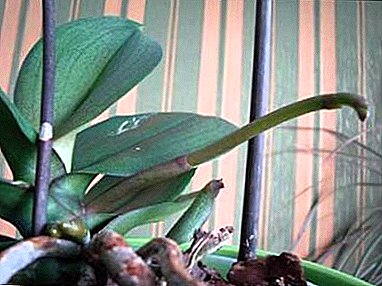 The top of the peduncle is cut with a knife, 2 - 3 cm is left above the sleeping kidney.
The top of the peduncle is cut with a knife, 2 - 3 cm is left above the sleeping kidney.- Sections are rubbed with pounded coal.
- Watering stops for a few days.
- Children are stimulated by growth hormone (the paste is applied on the cleaned kidney).
- Sprouts 5 cm in length with roots are separated.
- Young seedlings are strengthened in the soil.
- Required greenhouse mode.
Diseases and pests
- From spider mite help treatment of the root and leaves with insecticides. You can soak the flower by immersion in a disinfecting solution for 10 minutes.
- From fungal rot stem and root will require urgent transplantation, sanitary pruning of rotten parts. The shrub is treated with basezol.
- From Meatballs and Mealybug spraying of karbofos will help. Repeated preventive treatment will be required after 10 days.
Similar plants
There are several orchids that are very reminiscent of multiflora.
- Phalaenopsis Amabilis also characterized by abundant long flowering. The leaves are large, oblong.
- Pink orchid similar to Orchid Multiflora small flowers. Petals are rounded, gently - pink colors.
- Sander Orchid has long curved peduncles. The flowers are numerous, arranged symmetrically, the colors are varied.
- Orchid Midi Multiflora - Abundantly blooming variety of bred hybrids. The flowers are bright, purple hue.
- Mini Orchids also applies to medium sized varieties. The colors are varied, the leaves are oblong, bright green.
Conclusion
Orchid Multiflora not only decorates apartments, but also is an element of decor in the design of shop-windows of shops, cafes, salons, wedding bouquets.


 The top of the peduncle is cut with a knife, 2 - 3 cm is left above the sleeping kidney.
The top of the peduncle is cut with a knife, 2 - 3 cm is left above the sleeping kidney.

